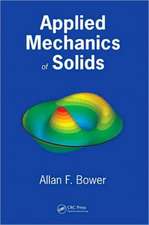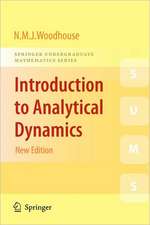Introduction to Solid Mechanics: An Integrated Approach
Autor Jacob Lubliner, Panayiotis Papadopoulosen Limba Engleză Hardback – 28 oct 2016
| Toate formatele și edițiile | Preț | Express |
|---|---|---|
| Paperback (2) | 409.13 lei 6-8 săpt. | |
| Springer – 23 aug 2016 | 409.13 lei 6-8 săpt. | |
| Springer International Publishing – 23 iun 2018 | 1164.78 lei 38-44 zile | |
| Hardback (2) | 428.18 lei 6-8 săpt. | |
| Springer International Publishing – 28 oct 2016 | 1159.87 lei 3-5 săpt. | |
| Springer – 8 noi 2013 | 428.18 lei 6-8 săpt. |
Preț: 1159.87 lei
Preț vechi: 1414.48 lei
-18% Nou
Puncte Express: 1740
Preț estimativ în valută:
221.94€ • 232.35$ • 183.64£
221.94€ • 232.35$ • 183.64£
Carte disponibilă
Livrare economică 15-29 martie
Preluare comenzi: 021 569.72.76
Specificații
ISBN-13: 9783319188775
ISBN-10: 3319188771
Pagini: 496
Ilustrații: XI, 533 p. 503 illus., 17 illus. in color.
Dimensiuni: 178 x 254 x 27 mm
Greutate: 12.87 kg
Ediția:2nd ed. 2017
Editura: Springer International Publishing
Colecția Springer
Locul publicării:Cham, Switzerland
ISBN-10: 3319188771
Pagini: 496
Ilustrații: XI, 533 p. 503 illus., 17 illus. in color.
Dimensiuni: 178 x 254 x 27 mm
Greutate: 12.87 kg
Ediția:2nd ed. 2017
Editura: Springer International Publishing
Colecția Springer
Locul publicării:Cham, Switzerland
Public țintă
Upper undergraduateCuprins
Forces and Moments.- Equilibrium.- Articulated Assemblages of Rigid Members.- Stress.- Deformation and Strain.- Elasticity.- Torsion.- Elastic Bending of Beams.- Additional Topics in Bending.- Elastic Stability and Buckling.- Inelasticity and Material Failure.- Appendix A: Singularity Functions.- Appendix B: Tables.- Photo Credits.- Index.
Notă biografică
Jacob Lubliner is Professor Emeritus in the Department of Civil and Environmental Engineering at UC Berkeley. Panos Papadopoulos is Professor of Mechanical Engineering at UC Berkeley.
Textul de pe ultima copertă
This expanded second edition presents in one text the concepts and processes covered in statics and mechanics of materials curricula following a systematic, topically integrated approach. Building on the novel pedagogy of fusing concepts covered in traditional undergraduate courses in rigid-body statics and deformable body mechanics, rather than simply grafting them together, this new edition develops further the authors’ very original treatment of solid mechanics with additional figures, an elaboration on selected solved problems, and additional text as well as a new subsection on viscoelasticity in response to students’ feedback. Introduction to Solid Mechanics: An Integrated Approach, Second Edition, offers a holistic treatment of the depth and breadth of solid mechanics and the inter-relationships of its underlying concepts. Proceeding from first principles to applications, the book stands as a whole greater than the sum of its parts.
Caracteristici
Introduces a new subsection on viscoelasticity Elaborates on selected solved problems Reinforces readers’ understanding with introductory overviews and updated exercises in each chapter Offers thorough presentation of fundamentals of the mechanics of deformable solids with concepts developed to their three-dimensional aspect Features section devoted to “simple stress states,” special cases in which stress can be determined by statics alone, and stress-based design is introduced as a consequence Discusses stress and strain transformations, including the determination of principal axes, from both the geometric and algebraic perspectives Discusses inelasticity and material failure, including descriptions of testing methods and comparisons of failure criteria, as well as structural collapse
Recenzii
From the book reviews:
“The book with its systematic and topically integrated approach from first principles to applications combines expertly the essentials of ‘statics’ and ‘strength of materials’ into a single valuable text, and could be recommended to engineering and science students and to teachers.” (M. Cengiz Dökmeci, zbMATH, Vol. 1288, 2014)
“The book with its systematic and topically integrated approach from first principles to applications combines expertly the essentials of ‘statics’ and ‘strength of materials’ into a single valuable text, and could be recommended to engineering and science students and to teachers.” (M. Cengiz Dökmeci, zbMATH, Vol. 1288, 2014)











